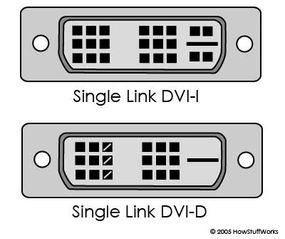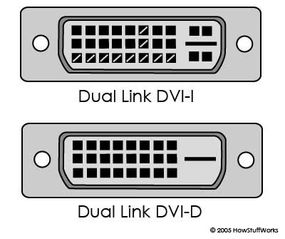Analog and DVI Connections
To display information on a monitor, your computer sends the monitor a signal. The signal can be in analog or digital format.
Analog (VGA) Connection
Because most CRT monitors require the signal information in analog (continuous electrical signals or waves) form and not digital (pulses equivalent to the binary digits 0 and 1), they typically use an analog connection.
Advertisement
However, computers work in a digital world. The computer and video adapter convert digital data into analog format. A video adapter is an expansion card or component that provides the ability to convert display information into a signal that is sent to the monitor. It can also be called a graphics adapter, video card or graphics card.
Once the display information is in analog form, it is sent to the monitor through a VGA cable. The cable connects at the back of the computer to an analog connector (also known as a D-Sub connector) that has 15 pins in three rows (see the diagram above):
- Red out
- Green out
- Blue out
- Unused
- Ground
- Red return (ground)
- Green return (ground)
- Blue return (ground)
- Unused
- Sync return (ground
- Monitor ID 0 in
- Monitor ID 1 in or data from display
- Horizontal Sync out
- Vertical Sync
- Monitor ID 3 in or data clock
You can see that a VGA connector like this has three separate lines for the red, green and blue color signals, and two lines for horizontal and vertical sync signals. In a normal television, all of these signals are combined into a single composite video signal. The separation of the signals is one reason why a computer monitor can have so many more pixels than a TV set.
Because a VGA (analog) connector does not support the use of digital monitors, the Digital Video Interface (DVI) standard was developed.
DVI Connection
DVI keeps data in digital form from the computer to the monitor. There's no need to convert data from digital information to analog information. LCD monitors work in a digital mode and support the DVI format. (Although, some also accept analog information, which is then converted to digital format.) At one time, a digital signal offered better image quality compared to analog technology. However, analog signal processing technology has improved over the years and the difference in quality is now minimal.
The DVI specification is based on Silicon Image's Transition Minimized Differential Signaling (TMDS) and provides a high-speed digital interface. A transmitter on the video adapter sends the digital information to a receiver in the monitor. TMDS takes the signal from the video adapter, determines the resolution and refresh rate that the monitor is using, and spreads the signal out over the available bandwidth to optimize the data transfer from computer to monitor.


DVI cables can be a single link cable that uses one TMDS transmitter or a dual link cable with two transmitters. A single link DVI cable and connection supports a 1920x1080 image, and a dual link cable/connection supports up to a 2048x1536 image.
There are two main types of DVI connections:
- DVI-digital (DVI-D) is a digital-only format. It requires a video adapter with a DVI-D connection and a monitor with a DVI-D input. The connector contains 24 pins/receptacles in 3 rows of 8 plus a grounding slot for dual-link support. For single-link support, the connector contains 18 pins/receptacles.
- DVI-integrated (DVI-I) supports both digital and analog transmissions. This gives you the option to connect a monitor that accepts digital input or analog input. In addition to the pins/receptacles found on the DVI-D connector for digital support, a DVI-I connector has 4 additional pins/receptacles to carry an analog signal.
If you buy a monitor with only a DVI (digital) connection, make sure that you have a video adapter with a DVI-D or DVI-I connection. If your video adapter has only an analog (VGA) connection, look for a monitor that supports the analog format.
